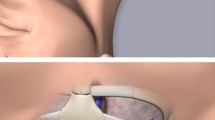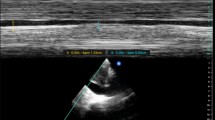Abstract
Background
Ultrasound-guided central venous puncture and fluoroscopic guidance during central venous catheter (CVC) positioning optimizes technical success and lowers the complication rates in children, and is therefore considered standard practice.
Objective
The purpose of this study was to compare the radiation exposure levels recorded during CVC placement in children weighing less than 10 kg in procedures performed using an image intensifier-based angiographic system (IIDS) to those performed in a flat-panel detector-based interventional suite (FPDS).
Materials and methods
A retrospective review of 96 image-guided CVC placements, between January 2008 and October 2013, in 49 children weighing less than 10 kg was performed. Mean age was 8.2 ± 4.4 months (range: 1–22 months). Mean weight was 7.1 ± 2.7 kg (range: 2.5–9.8 kg). The procedures were classified into two categories: non-tunneled and tunneled CVC placement.
Results
Thirty-five procedures were performed with the IIDS (21 non-tunneled CVC, 14 tunneled CVC); 61 procedures were performed with the FPDS (47 non-tunneled CVC, 14 tunneled CVC). For non-tunneled CVC, mean DAP was 113.5 ± 126.7 cGy cm2 with the IIDS and 15.9 ± 44.6 cGy · cm2 with the FPDS (P < 0.001). For tunneled CVC, mean DAP was 84.6 ± 81.2 cGy · cm2 with the IIDS and 37.1 ± 33.5 cGy cm2 with the FPDS (P = 0.02).
Conclusion
The use of flat-panel angiographic equipment reduces radiation exposure in small children undergoing image-guided CVC placement.


Similar content being viewed by others
References
Lameris JS, Post PJ, Zonderland HM et al (1990) Percutaneous placement of Hickman catheters: comparison of sonographically guided and blind techniques. AJR Am J Roentgenol 155:1097–1099
Jaques PF, Mauro MA, Keefe B (1992) US guidance for vascular access. Technical note. J Vasc Interv Radiol 3:427–430
Donaldson JS (2006) Pediatric vascular access. Pediatr Radiol 36:386–397
Krishnamurthy G, Keller MS (2011) Vascular access in children. Cardiovasc Intervent Radiol 34:14–24
Ganeshan A, Warakaulle DR, Uberoi R (2007) Central venous access. Cardiovasc Intervent Radiol 30:26–33
Tercan F, Oguzkurt L, Ozkan U et al (2008) Comparison of ultrasonography-guided central venous catheterization between adult and pediatric populations. Cardiovasc Intervent Radiol 31:575–580
Adeb M, Baskin KM, Keller MS et al (2012) Radiologically placed tunneled hemodialysis catheters: a single pediatric institutional experience of 120 patients. J Vasc Interv Radiol 23:604–612
Storm ES, Miller DL, Hoover LJ et al (2006) Radiation doses from venous access procedures. Radiology 238:1044–1050
Govia K, Connolly BL, Thomas KE et al (2012) Estimates of effective dose to pediatric patients undergoing enteric and venous access procedures. J Vasc Interv Radiol 23:443–450
Nickoloff EL (2011) AAPM/RSNA physics tutorial for residents: physics of flat-panel fluoroscopy systems: survey of modern fluoroscopy imaging: flat-panel detectors versus image intensifiers and more. Radiographics 31:591–602
American Society of Anesthesiologists Committee (2011) Practice guidelines for preoperative fasting and the use of pharmacologic agents to reduce the risk of pulmonary aspiration: application to healthy patients undergoing elective procedures: an updated report by the american society of anesthesiologists committee on standards and practice parameters. Anesthesiology 114:495–511
Baskin KM, Jimenez RM, Cahill AM et al (2008) Cavoatrial junction and central venous anatomy: implications for central venous access tip position. J Vasc Interv Radiol 19:359–365
Adwan H, Gordon H, Nicholls E (2008) Are routine chest radiographs needed after fluoroscopically guided percutaneous insertion of central venous catheters in children? J Pediatr Surg 43:341–343
Suzuki S, Furui S, Kobayashi I et al (2005) Radiation dose to patients and radiologists during transcatheter arterial embolization: comparison of a digital flat-panel system and conventional unit. AJR Am J Roentgenol 185:855–859
Miraglia R, Maruzzelli L, Tuzzolino F et al (2013) Radiation exposure in biliary procedures performed to manage anastomotic strictures in pediatric liver transplant recipients: comparison between radiation exposure levels using an image intensifier and a flat-panel detector-based system. Cardiovasc Intervent Radiol 36:1670–1676
Wiesinger B, Kirchner S, Blumenstock G et al (2013) Difference in dose area product between analog image intensifier and digital flat panel detector in peripheral angiography and the effect of BMI. RöFo 185:153–159
Wiesinger B, Stutz A, Schmehl J et al (2012) Comparison of digital flat-panel detector and conventional angiography machines: evaluation of stent detection rates, visibility scores, and dose-area products. AJR Am J Roentgenol 198:946–954
Bogaert E, Bacher K, Lapere R et al (2009) Does digital flat detector technology tip the scale towards better image quality or reduced patient dose in interventional cardiology? Eur J Radiol 72:348–353
Sidhu M, Coley BD, Goske MJ et al (2009) Image gently, step lightly: increasing radiation dose awareness in pediatric interventional radiology. Pediatr Radiol 39:1135–1138
Sidhu M (2010) Radiation safety in pediatric interventional radiology: step lightly. Pediatr Radiol 40:511–513
Conflicts of interest
None
Author information
Authors and Affiliations
Corresponding author
Rights and permissions
About this article
Cite this article
Miraglia, R., Maruzzelli, L., Cortis, K. et al. Comparison between radiation exposure levels using an image intensifier and a flat-panel detector-based system in image-guided central venous catheter placement in children weighing less than 10 kg. Pediatr Radiol 45, 235–240 (2015). https://doi.org/10.1007/s00247-014-3119-5
Received:
Revised:
Accepted:
Published:
Issue Date:
DOI: https://doi.org/10.1007/s00247-014-3119-5




